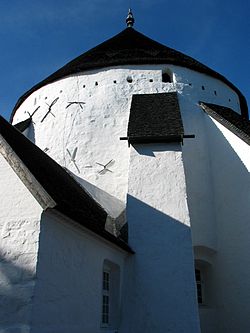This article needs additional citations for verification .(March 2023) |

A round church is a church with a completely circular plan, thus a rotunda in architectural terms.
Contents
- Round churches by country
- Armenia
- Bosnia
- Brazil
- Bulgaria
- Canada
- Croatia
- Czech Republic
- Denmark
- Ethiopia
- France
- Germany
- Hungary
- Italy
- Malta
- Mexico
- The Netherlands
- Norway
- Philippines
- Portugal
- Serbia
- Spain
- Sweden
- United Kingdom
- United States of America
- Gallery
- See also
- References
- External links
There are many Nordic round churches in Sweden and Denmark (notably the island of Bornholm); round churches were popular in Scandinavia in the 11th and early 12th centuries.
Round churches should not be confused with the older types of round-tower church constructions. Churches with many-sided polygonal shapes (such as the 16-sided example in Richmond, Vermont, United States) are likewise colloquially referred to as 'round'.











